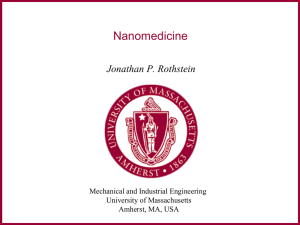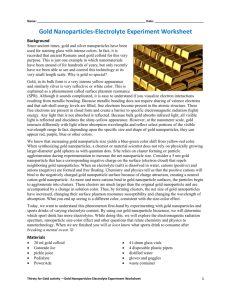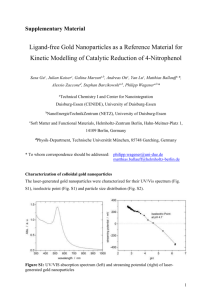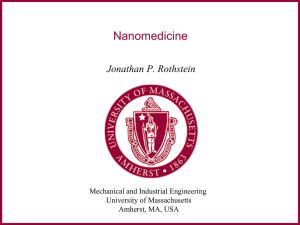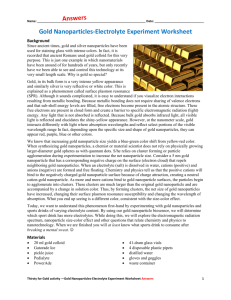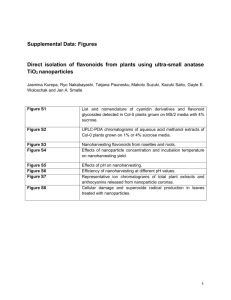Lesson3.4a FinalBuild A Particle- Student
advertisement
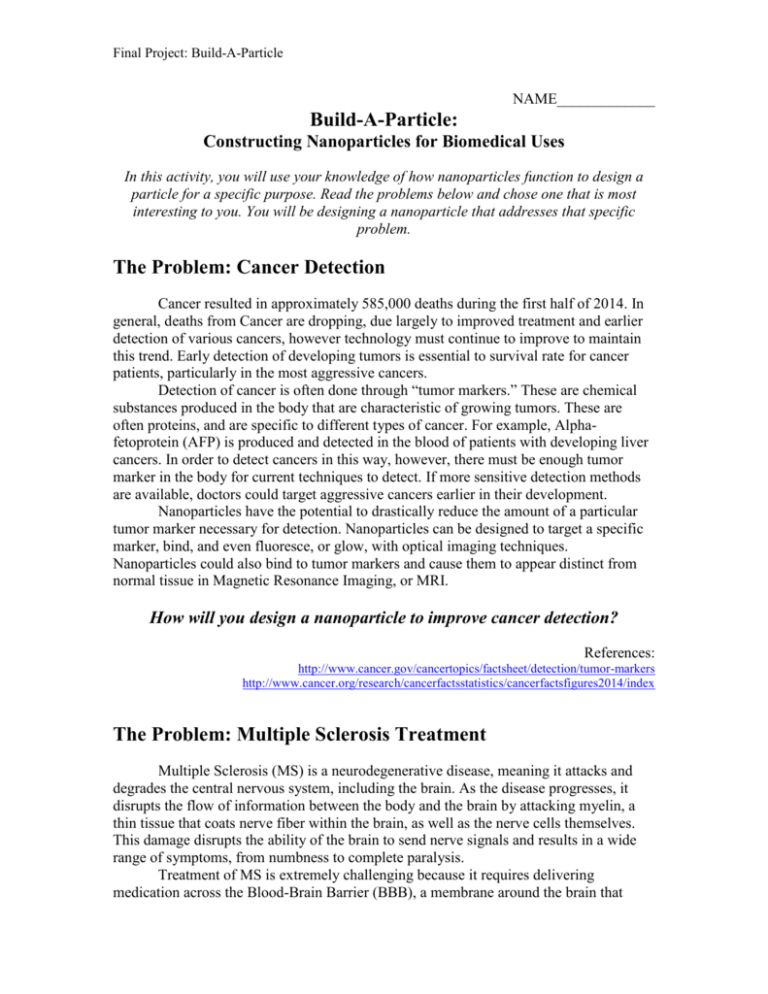
Final Project: Build-A-Particle NAME_____________ Build-A-Particle: Constructing Nanoparticles for Biomedical Uses In this activity, you will use your knowledge of how nanoparticles function to design a particle for a specific purpose. Read the problems below and chose one that is most interesting to you. You will be designing a nanoparticle that addresses that specific problem. The Problem: Cancer Detection Cancer resulted in approximately 585,000 deaths during the first half of 2014. In general, deaths from Cancer are dropping, due largely to improved treatment and earlier detection of various cancers, however technology must continue to improve to maintain this trend. Early detection of developing tumors is essential to survival rate for cancer patients, particularly in the most aggressive cancers. Detection of cancer is often done through “tumor markers.” These are chemical substances produced in the body that are characteristic of growing tumors. These are often proteins, and are specific to different types of cancer. For example, Alphafetoprotein (AFP) is produced and detected in the blood of patients with developing liver cancers. In order to detect cancers in this way, however, there must be enough tumor marker in the body for current techniques to detect. If more sensitive detection methods are available, doctors could target aggressive cancers earlier in their development. Nanoparticles have the potential to drastically reduce the amount of a particular tumor marker necessary for detection. Nanoparticles can be designed to target a specific marker, bind, and even fluoresce, or glow, with optical imaging techniques. Nanoparticles could also bind to tumor markers and cause them to appear distinct from normal tissue in Magnetic Resonance Imaging, or MRI. How will you design a nanoparticle to improve cancer detection? References: http://www.cancer.gov/cancertopics/factsheet/detection/tumor-markers http://www.cancer.org/research/cancerfactsstatistics/cancerfactsfigures2014/index The Problem: Multiple Sclerosis Treatment Multiple Sclerosis (MS) is a neurodegenerative disease, meaning it attacks and degrades the central nervous system, including the brain. As the disease progresses, it disrupts the flow of information between the body and the brain by attacking myelin, a thin tissue that coats nerve fiber within the brain, as well as the nerve cells themselves. This damage disrupts the ability of the brain to send nerve signals and results in a wide range of symptoms, from numbness to complete paralysis. Treatment of MS is extremely challenging because it requires delivering medication across the Blood-Brain Barrier (BBB), a membrane around the brain that Final Project: Build-A-Particle restricts the flow of substances into or out of the brain. This barrier means that medications must be delivered in extremely high concentrations, often with higher risks and more serious side effects. Nanoparticles, because they are small and customizable, have the potential to deliver medications across the BBB, requiring lower dosages and therefore limiting harmful side effects. To do this, they must remain small and contain a mechanism that allows it to cross the BBB. How will you design a nanoparticle to better deliver Multiple Sclerosis treatments? References: http://www.nationalmssociety.org/What-is-MS https://faculty.washington.edu/chudler/bbb.html The Problem: Asthma Asthma is a chronic condition that results in inflamed airways and difficulty breathing. In the United States alone, around 25 million people are diagnosed with Asthma, with numbers on the rise. It has no cure and can only be treated symptomatically, typically with an inhaler once an attack is triggered. An Asthma attack happens when the tissue lining the airways of the body, which lead to the lungs, react to an inhaled substance. This substance, whatever it may be, causes muscles around the airways to tighten, shrinking the airways themselves. Next, cells lining the airways produce mucus, a sticky, viscous liquid that fills and further compacts the airways. This tightening of the airways results in difficulty breathing, wheezing, coughing and an overall frightening experience for the victim. Studies have shown that asthma victims often suffer from a lack of a compound called Interferongamma, a protein that helps control and regulate the body’s immune responses. This may be a root cause of the excessive inflammation of the airways during an asthma attack, which is, at its core, an inappropriate immune system response. Nanoparticles could alter a person’s gene expression and encourage production of Interferon-gamma. This would reverse any interferon deficiencies in an Asthma sufferer, realigning the body’s immune system response and limiting airway inflammation. This would also provide ongoing treatment of asthma and prevent attacks, rather than serving as a response to a triggered attack. How will you design a nanoparticle to limit the effects of asthma? References: http://www.nhlbi.nih.gov/health/health-topics/topics/asthma/ http://www.lung.org/lung-disease/asthma/learning-more-about-asthma/ http://www.bio.davidson.edu/courses/immunology/students/spring2006/v_alvarez/ifn-gamma.html Final Project: Build-A-Particle The Problem: Antimicrobial Resistance Today’s medicine relies heavily on antibiotic medications that combat bacterial infections. Bacteria, however, are rapidly evolving to fight back, developing resistance to our infantry of pharmaceutical interventions. Our drugs, in fact, are speeding the evolution of a growing body of drug-resistant microbes. For example, Extensively DrugResistant Tuberculosis is spreading worldwide, requiring even longer, more intense treatment. Malaria is also becoming more difficult to treat, as well as common bacteria, such as those that cause Pneumonia and Strep Throat. Nanoparticles have potential to be a new kind of microbe-fighter- one that makes resistance difficult to evolve. Nanoparticles can locate and attract foreign cells, like those of a fungus or bacteria, using the negative charge of the cell membranes of most microbes to locate and attract microbes. Then, nanoparticles can bind to cell membranes (when given the proper structure) and physically destroy the outer layer of the microbe, causing them to die and fall apart. This physical destruction, rather than the chemical attack made by present-day antimicrobials, means that resistance will be extremely difficult to develop, even for the most quickly evolving microbes. How will you develop a microbe-busting nanoparticle to fight antibioticresistant superbugs? References: http://www.who.int/mediacentre/factsheets/fs194/en/ http://www.research.ibm.com/featured/ninjas/?lnk=ushpls1#fbid=a0ddYjYxpJ- DIRECTIONS: 1. In your chosen “Problem” paragraph, underline or highlight 3-5 important features of the specific problem that you may need to consider when designing a nanoparticle-based solution. 2. Read through the “Nano-Pieces” tables and put stars next to components that may be relevant to the chosen problem. 3. Re-read the “Problem” paragraph, keeping in mind the Nano-pieces you have starred. Do they work? Do you need any other pieces? Do you have unnecessary pieces? 4. Once you have decided on the necessary pieces, draw a labeled diagram of your nanoparticle- label both the name and size of each feature. Use the provided images as a guide, but feel free to be creative as well. Keep relative sizes in mind on your diagram. 5. Write an analysis of your nanoparticle, including an evaluation of its form, function and weaknesses. This will be used to create a playing card for your molecule. Final Project: Build-A-Particle Nano-Pieces: Table 1. Base Nanoparticle Characteristics Image - Negatively charged surface Silica Dioxide Size: 20 nm* - Stable - Low Toxicity - Used in drug delivery and plastics Image: http://en.wikipedia.org/wiki/Mesoporous_silica - Common material for cell membranes Liposome Size: 50 nm - Form transport vesicles that can bypass biological barriers and carry substances through body - Outside can be charged - Can attach specific binding molecules when required Image: http://mml.umd.edu/mml/projects.html - Long chains of nanoparticles Nanopolymer Size: 100 nm - Surface can be given positive charge - Used in many Nanomaterials Image: http://news.medill.northwestern.edu/ Final Project: Build-A-Particle - Biodegradable and biocompatible - Made from chitin, found in fungal cell walls Chitosan Size: 83 nm - Used in gene expression therapy, which alters the behavior of some genes - Affects the production of Interferon - Attaches well to mucus and mucus membranes Super Paramagnetic Iron Oxide (SPIO) Image: http://www.advancell.net/?page_id=325 - Magnetic, but adjustable - Can be attached to other molecules, such as DNA, antibodies or peptides Size: 12 nm Image: http://openi.nlm.nih.gov Table 2. Accessory Molecules Characteristics - Attachable to nanoparticles (3-Aminopropyl triethoxysilane) - Links extra molecules to Nano surfaces Size: .7 nm - Highly adaptable - Toxic in gas form APTES Image Image: http://commons.wikimedia.org/wiki/File:APTES .svg Final Project: Build-A-Particle - Raman Detectors Size: approximately 2 nm Prednisolone Size: 10 nm Produces a unique pattern in absorption/reflection of light in presence of specific materials - Useful in detection - Drug used in treatment of Multiple Sclerosis - Cannot be attached to a particle, but could be carried No image available Image: http://commons.wikimedia.org/wiki/File:Prednis olone.svg PEG (Polyethylene Glycol) Size: 5 nm but larger in water Calcein AM Probe Size: approximately 27 nm - Long, chain-like molecule - Size can adjusted as needed - Useful in masking surface charges on molecules until necessary - Water Soluble (dissolves in water) - Crosses Blood-Brain Barrier - Attaches to many molecules - Fluoresces or glows in living cells - Safe for use in live organisms Image: http://www.staff.ncl.ac.uk/r.w.harrington/polyeth yleneglycol.html Image: http://www.enzolifesciences.com/ENZ52002/calcein-am-ultra-pure/ - Identifies and attaches to antibodies produced during tumor growth - Limits development of tumors Herceptin Size: 58 nm Image: http://www.3dchem.com/molecules.asp?ID=194 *nm = nanometer Final Project: Build-A-Particle NANO-PARTICLE DIAGRAM PROBLEM: _______________________ Remember: Label both the name and size of each feature. Keep relative sizes in mind on your diagram. Final Project: Build-A-Particle ANALYSIS: 1. Explain the overall design of the nanoparticle and its function (What does it do and how does it work?) 2. Explain of each individual part of the nanoparticle (What is its specific function and why did you choose that component?) 3. What is the total size of your particle? How will this affect its functionality in terms of surface area? 4. Explain 1 weakness of your particle and how it might affect its function. 5. Create a playing card to commemorate your new nanoparticle. Include with the card a labeled diagram, description of how the nanoparticle works (its superpowers), and an explanation of its parts. You will be scored on Accuracy, Reasoning, Clarity and Creativity.




